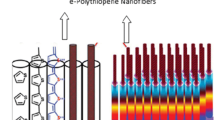Abstract
In this work, we present the results of investigation of the nanoporous material – carbon fabrics, which is used as electrodes in rechargeable energy storage capacitors (ultracapacitors). The impurity composition in the fabrics, the influence of thermal annealing conditions on the impurity concentration is studied. The performed studies resulted in determination of the investigated carbon material structure, determination of impurity composition of carbon material and change of impurity content depending on thermal treatment in vacuum at different temperatures and time intervals. The optimum temperature range for the treatment of carbon fabrics in vacuum that is important for its application in energy storage devices is found.
Similar content being viewed by others
References
B. Conway, Electrochemical supercapacitors. (Klawer Academic Plenum Publishers, New York, 1999), p. 698.
Ultracapacitors (2006). Available at: http://www.hybridcars.com/ultracapacitors (accessed 01 March 2018)
S.M. Karabanov and Y.V. Kukhmistrov, Electronnaya promyshlennost, 6, 72, (1994).
Sergey Karabanov, Dmitriy Suvorov, Andrey Karabanov, Dmitry Tarabrin, Evgeniy Slivkin and Gennadiy Gololobov, in Mathematical Modeling of Stand-alone PV Power Systems with the Use of Hybrid Energy Storage Units based on Ultra Capacitor, (31st Europ. Photovolt. Solar Energy Conf. Proc., Hamburg, Germany, 2015) pp. 2374 – 2377.
S.M. Karabanov, D.V. Suvorov, Y.V. Kukhmistrov and E.V. Slivkin, in The Study of PV modules with electric double layer capacitors integrated in their structure, (28th Europ. Photovolt. Solar Energy Conf. Proc., Paris, France, 2013) pp. 511–516.
A.Yu. Rychagov, Yu.M. Volfkovich, Elektrokhimicheskaya Energetika, 12 (4), 167 (2012).
D.E. Vervikishko, Correlation between the nanoporous carbon materials structure and functional characteristics of ultracapacitors on their basis, Thesis, JIHT RAS, Moscow, 2014.
A.A. Mikhalin, Study of capacitive and electrochemical properties of electrodes based on finely dispersed carbon in relation to their use in ultracapacitors and for capacitive water deionization, Thesis, IPCE RAS, Moscow, 2013.
S.M. Karabanov, V.G. Litvinov and A.S. Karabanov, MRS Advances, 54 (2), 3255, (2017).
Author information
Authors and Affiliations
Rights and permissions
About this article
Cite this article
Karabanov, S.M., Litvinov, V.G., Rybin, N.B. et al. Study of Nanoporous Carbon Fabrics for Rechargeable Energy Storage Capacitors. MRS Advances 3, 3227–3232 (2018). https://doi.org/10.1557/adv.2018.443
Published:
Issue Date:
DOI: https://doi.org/10.1557/adv.2018.443




